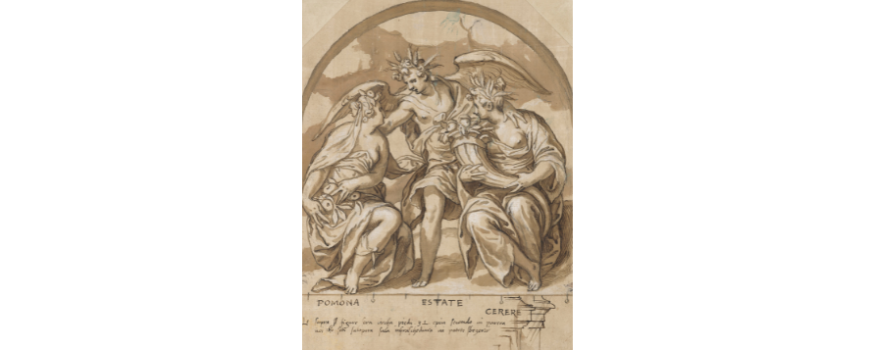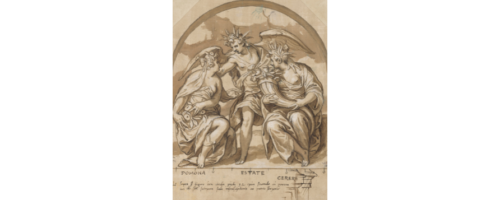The King’s Gallery in London, part of Royal Collection Trust, is set to host a new exhibition, Drawing the Italian Renaissance, from 1 November 2024 to 9 March 2025.
This exhibition will present the largest collection of drawings from this pivotal artistic period ever displayed in the UK.
Exploring the diversity and accomplishment of drawing across Italy between 1450 and 1600, the exhibition will feature around 160 works by over 80 artists including Leonardo da Vinci, Michelangelo, Raphael and Titian, all drawn from the Royal Collection, which holds one of the world’s greatest collections of Italian Renaissance drawings. Over 30 works will be displayed for the first time, and a further 12 have never been shown in the UK.
Martin Clayton, curator of Drawing the Italian Renaissance said, “The Royal Collection holds an astonishing array of Renaissance drawings. These big, bold, and colourful studies show just how exciting the art of drawing became during this time. The Italian Renaissance would have been impossible without drawing – it was central to every stage of the creative process. These drawings cannot be on permanent display for conservation reasons, so the exhibition is a unique opportunity to see such a wide range of drawings up-close and gain an insight into the minds of these great Italian Renaissance artists.”
The Renaissance saw a growing appreciation of individual creativity and a dramatic transformation in how artists worked. Drawing was at the heart of this development, evolving from a simple tool of workshop practice to an exciting means of exploring visual ideas, developing new compositions, and studying the world.
Most drawings from this period were created as preparation for projects in various media, from paintings and prints to architecture, sculpture, metalwork, tapestry and costume, with a small number created as works of art in their own right. Together, these works reflect the artists’ creative genius and the infinitely varied medium of drawing.
Arranged thematically, the exhibition opens with an exploration of life drawing. Artists usually drew from posed models, often their male assistants, to hone their skills and pursue originality and dynamism in their compositions. A star drawing is Raphael’s The Three Graces in red chalk, c.1517–18, a study of one model in three poses, made for his fresco of the Wedding Feast of Cupid and Psyche in the Villa Farnesina, Rome. Raphael was among the few Renaissance artists to draw from a nude female model. Another highlight will be Fra Angelico’s detailed head study The bust of a cleric, c.1447–50, thought to have been done in preparation for his frescos in the chapel of Pope Nicolas V in the Vatican. It is the earliest sheet on display and a rare surviving drawing by the great Florentine painter.
Studies of plants and animals will demonstrate artists’ search for realism and an understanding of the natural world. One remarkable example is a chalk study of an ostrich, c.1550, attributed to Titian. The convincing proportions and stance of the bird indicate that the artist had seen a live ostrich, and the technique points to an artist from Venice, Italy’s main port for trade with the eastern and southern Mediterranean, from where an ostrich could have been imported as an exotic curiosity. This surprising subject is one of 12 works going on display in the UK for the first time.
A section exploring designs for the applied arts will show that the leading artists of the Renaissance were skilled all-round designers who could be asked to devise works in any medium. A striking example is A costume study for a masque by Leonardo da Vinci, c.1517–18. Leonardo spent the last years of his life at the French court and designed fantastical costumes for the festivities held by the French king, Francis I. In this extravagant study, he demonstrates his abilities through the rich layering of fabrics, including ribbons, scalloping, plumes, spotted furs, and quilted sleeves and breeches.
The exhibition will introduce visitors to works by lesser-known artists on display for the first time, which reveal the variety and richness of the medium. They include Paolo Farinati’s c.1590 study of three mythological figures under an arch, on which the artist inscribed instructions to his assistants: ‘You may do it as you fancy when you are on the scaffolding’. Also on display for the first time will be a large, confident ink study of St Jerome by Bartolomeo Passarotti, c.1580, an artist who specialised in vigorous pen drawings.
The gallery’s final room will explore both sacred compositions, such as Michelangelo’s The Virgin and Child with the young Baptist, c.1532, and secular decorations, including fresco designs by members of the Carracci family. Also on display will be a small group of drawings made as finished works of art, to be given as gifts or collected as exemplars of an artist’s creativity. Giovanni Bellini’s The head of an old man, c.1460–70, was evidently framed and hung, as there are holes at the edges from being tacked to a panel, a layer of varnish was applied, and the blue paper shows discolouration from exposure to light.
Throughout the exhibition, visitors will learn how the materials available to artists expanded significantly during this period. By the end of the 16th century, an artist could tone their paper with a coloured wash or preparation, sketch out a composition in chalk, fix the outlines with a pen, and add broad washes of dilute ink for modelling, as well as highlights in liquid lead white. All of these stages can be seen in Alessandro Allori’s allegorical designs from c.1578 for the decoration of Poggio a Caiano, the Medici family villa outside Florence.
Drawing has continued to diversify to the present day, and it still forms an essential part of many artists’ practice. Three Artists in Residence, appointed in partnership with the Royal Drawing School, will draw in the gallery spaces on Mondays, Thursdays, and Fridays throughout the exhibition’s run. Visitors to the exhibition are also encouraged to draw—paper and pencils will be available.
Click here to book your tickets to the exhibition.










